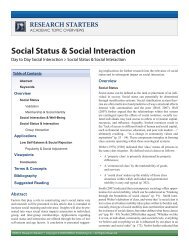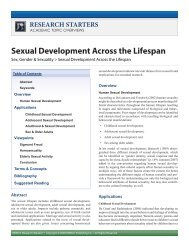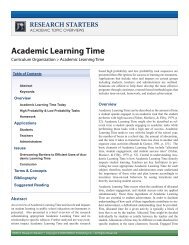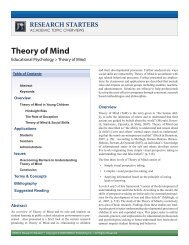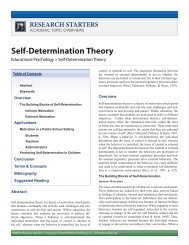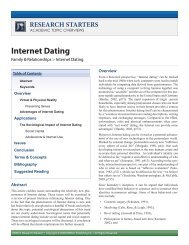Graphic Organizers - DSWLeads.com
Graphic Organizers - DSWLeads.com
Graphic Organizers - DSWLeads.com
Create successful ePaper yourself
Turn your PDF publications into a flip-book with our unique Google optimized e-Paper software.
RESEARCH STARTERS<br />
ACADEMIC TOPIC OVERVIEWS<br />
<strong>Graphic</strong> <strong>Organizers</strong><br />
Special Education > <strong>Graphic</strong> <strong>Organizers</strong><br />
Table of Contents<br />
Abstract<br />
Keywords<br />
Overview<br />
Applications<br />
Abstract<br />
<strong>Graphic</strong> <strong>Organizers</strong> & Reading<br />
<strong>Graphic</strong> <strong>Organizers</strong> & Science<br />
<strong>Graphic</strong> <strong>Organizers</strong> & Social Studies<br />
<strong>Graphic</strong> <strong>Organizers</strong> & Math<br />
<strong>Graphic</strong> <strong>Organizers</strong> & Students With<br />
Disabilities<br />
Further Insights<br />
Students<br />
Teachers<br />
Administrators<br />
Issues<br />
Over<strong>com</strong>ing Barriers to Using <strong>Graphic</strong><br />
<strong>Organizers</strong><br />
Terms & Concepts<br />
Bibliography<br />
Suggested Reading<br />
An overview of <strong>Graphic</strong> <strong>Organizers</strong> and their role and impacts<br />
on student learning in public school education environments<br />
is presented. Also presented is a brief overview of the current<br />
research pertaining to <strong>Graphic</strong> <strong>Organizers</strong>, their role in helping<br />
children analyze and synthesize information, and their relationship<br />
in helping children organize information despite “ability<br />
level” or developmental understanding. Further analyzed are<br />
ways specific academic skills are impacted through the use of<br />
<strong>Graphic</strong> <strong>Organizers</strong> in accordance with learning styles and age<br />
related behavioral processes. Also presented are implications<br />
for classrooms and applications that include roles and impacts<br />
on certain groups including students, teachers, and administrators.<br />
Solutions are offered to help professionals develop the most<br />
effective programs through consistent, research based methodologies<br />
and philosophies.<br />
Overview<br />
<strong>Graphic</strong> organizers serve as a visual framework (Ausubel,<br />
1960) that offers teachers and students multiple and differentiated<br />
opportunities to utilize a tool to develop concepts, organize<br />
language, and better understand subjects, in order to apply information<br />
to achieve a variety of purposes and out<strong>com</strong>es. <strong>Graphic</strong><br />
organizers, or concept maps (Novak & Gowin 1984), help students<br />
sort, simplify, show relationships, make meaning, and<br />
manage data quickly and easily (Crawford & Carnine, 2000).<br />
Bromley, Irwin-DeVitis, and Modlo (1995) defined graphic organizers<br />
as a visual representation(s) of knowledge. Organizing<br />
information graphically allows students to structure information<br />
or arrange aspects of a concept or a topic into a pattern using<br />
labels (p. 6). Essentially and meaningfully, graphic organizers<br />
enable students to sort data, illustrate relationships, make meaning,<br />
and manage data quickly and easily before, during, and after<br />
reading and during classroom or group discussions. <strong>Graphic</strong><br />
organizers are useful for reading difficult material, accentuating<br />
information, honoring cultural diversity, meeting needs of<br />
special populations, and supporting language learning. In addition<br />
to facilitating understanding for multiple subjects, graphic<br />
organizers help students with learning disabilities or academic<br />
deficits make sense of information in multiple disciplines.<br />
<strong>Graphic</strong> organizers are useful for multiple reasons. First, the<br />
reality of public education classrooms is that learning needs for<br />
all students spans a wide-ranging spectrum. Second, to educate<br />
all students in the least restrictive environment typically mandates<br />
that both special education students and general education<br />
EBSCO Research Starters ® • Copyright © 2008 EBSCO Publishing Inc. • All Rights Reserved
<strong>Graphic</strong> <strong>Organizers</strong><br />
Essay by Sharon Link, Ph.D.<br />
Keywords<br />
Concept Map<br />
Differentiated Instruction<br />
<strong>Graphic</strong> <strong>Organizers</strong><br />
Meaningful Verbal Learning<br />
Semantic Map<br />
students will be educated in a general education classroom.<br />
Third, the mandate for least restrictive environment results in<br />
the expectation that all students will learn the same curricular<br />
content (Baxendell, 2003, p. 46). As a result, teachers are often<br />
called upon to decide specific instructional tools for use with all<br />
students. Based on present research, teachers have access to multiple<br />
research-based techniques, strategies, and devices that allow<br />
them to meet their students’ varying needs (Fisher & Schumaker,<br />
1995). Choosing optimal instructional devices for students with<br />
special needs can be difficult, because students with special<br />
needs may experience difficulty understanding, organizing, or<br />
recalling important facts or details or discipline content (Fountas<br />
& Pinnell, 2001).<br />
<strong>Graphic</strong> organizers are a specific instructional organizational<br />
tool available to teachers that are <strong>com</strong>monly utilized in many<br />
classrooms (Egan, 1999). Instructional researchers that formulated<br />
the use of graphic organizers re<strong>com</strong>mend key principles in<br />
designing effective graphic organizers which include coherence,<br />
consistency, and creativity (Baxendell, 2003, p. 46). A wealth<br />
of research can be accessed that describes the benefit and positive<br />
impact that graphic organizers have on students’ ability to<br />
<strong>com</strong>prehend and organize information in multiple subject areas<br />
including, but not limited to, reading, science, social studies, and<br />
math.<br />
Applications<br />
<strong>Graphic</strong> <strong>Organizers</strong> & Reading<br />
In order for students to learn to read effectively, students must<br />
be able to generate meaning from the text or <strong>com</strong>prehend their<br />
reading (Duke & Pearson, 2002; Pressley, 2000). Learning to<br />
read can be a daunting task for many children, especially those<br />
with disabilities (LD, Bryant, Vaughn, Linan-Thompson, Ugel,<br />
& Hamff, 2000; Gersten, Fuchs, Williams, & Baker, 2001).<br />
The most successful reading teachers are those that understand<br />
that reading can be a <strong>com</strong>plex and difficult process (Vaughn &<br />
Edmonds, 2006, p. 131). <strong>Graphic</strong> organizers have been re<strong>com</strong>mended<br />
as helpful instruments for teaching students to read.<br />
<strong>Graphic</strong> organizers “can include such practices as semantic<br />
mapping, semantic feature analysis, cognitive maps, story<br />
maps,advanced organizers, visual and spatial displays, and Venn<br />
diagrams. As a result of these organizers, students can connect<br />
ideas and concepts and improve their text <strong>com</strong>prehension”<br />
(Vaughn & Edmonds, 2006, p. 134). Mounting evidence indicates<br />
individuals with learning disabilities can dramatically benefit<br />
from graphic organizers utilized to facilitate <strong>com</strong>prehension of<br />
expository text (Kim, Vaughn, Wanzek, & Wei, 2004). The most<br />
effective graphic organizers that can be used to help children<br />
improve reading <strong>com</strong>prehension are those graphic organizers<br />
that relate to the instructional text or the unit that is being taught<br />
(Vaughn & Edmonds, 2006, p. 135). A semantic map can be used<br />
to provide “an overview of key vocabulary and concepts” (p. 135).<br />
A concept map can be “used to extend understanding of central<br />
ideas by determining how they are defined and their characteristics”<br />
(Vaughn & Edmonds, 2006, p. 135). <strong>Graphic</strong> organizers<br />
can be used to facilitate learning for other subjects, as well.<br />
<strong>Graphic</strong> <strong>Organizers</strong> & Science<br />
No Child Left Behind (NCLB) has required that “students with<br />
disabilities must be assessed in science once during each grade<br />
span (3 - 5, 6 - 9, and 10 - 12), along with all other general<br />
education students starting with the 2007 - 2008 school year.<br />
While appropriate testing ac<strong>com</strong>modations must be offered,<br />
research indicates that instructional issues play a vital role in<br />
helping students with disabilities learn” (“Science for Students,”<br />
2007, p. 65). For students with disabilities, multiple issues with<br />
organization, memory, reading, and writing makes information<br />
difficult to grasp and retaining <strong>com</strong>plex material a challenge.<br />
According to ERIC (2003), in order to teach students with disabilities,<br />
students may need modifications such as “advance and<br />
graphic organizers, instructional scaffolding, additional practice<br />
and time to <strong>com</strong>plete assignments, and /or alternative media<br />
(e.g., large-print materials, audiotapes, or electronic materials)”<br />
(“Science for Students,” 2007, p. 65). Along with science,<br />
graphic organizers also improve understanding in social studies.<br />
<strong>Graphic</strong> <strong>Organizers</strong> & Social Studies<br />
Specific types of graphic organizers empower social studies<br />
teachers and students to control a large amount of reading,<br />
manage a multitude of ideas, and consider various perspectives<br />
associated with learning social studies, especially citizenship<br />
and government, economics, geography, and history (Flood &<br />
Lapp, 1988). <strong>Graphic</strong> organizers provide practical classroom<br />
tools that immediately engage students and connect them with<br />
content and processes while working independently, with partners,<br />
in small groups, or as a whole class (Hew et al. 2004).<br />
Teachers or students can create graphic organizers as tools<br />
to process or integrate into the product; they can be created<br />
on paper, on a board, or with <strong>com</strong>puter software. According<br />
to researchers, students using graphic organizers are more<br />
motivated, demonstrate more efficient short-term recall, and<br />
demonstrate more significant long-term achievement when organizers<br />
are used effectively in social studies. It can be argued<br />
that graphic organizers empower students to take responsibility<br />
for their own learning, facilitate and personalize meaning,<br />
share information with others, and make group presentations<br />
(MacKinnon & Deppell, 2005). From the research, graphic<br />
EBSCO Research Starters ® • Copyright © 2008 EBSCO Publishing Inc. • All Rights Reserved Page 2
<strong>Graphic</strong> <strong>Organizers</strong><br />
Essay by Sharon Link, Ph.D.<br />
organizers can be used in social studies in three different ways.<br />
First, graphic organizers can be used before reading and discussion<br />
as a way to pre-assess knowledge, introduce or preview a new<br />
topic, brainstorm ideas, and motivate student interest. Second,<br />
graphic organizers can be utilized during reading and discussion<br />
to provide an instrument for note taking, retaining information,<br />
checking progress, extending learned information, evaluating<br />
learned information, and renewing interest. Third, graphic<br />
organizers can be used after reading and discussion to review,<br />
reinforce, or assess learning, establish the foundation for future<br />
projects and activities, and serve as an evaluation tool (Vacca<br />
& Vacca, 2001). <strong>Graphic</strong> organizers offer teachers and students<br />
opportunities to recognize what is known, dispel misinformation<br />
and misconceptions, brainstorm new possibilities, predict out<strong>com</strong>es,<br />
process information, share ideas, and see their out<strong>com</strong>es<br />
in simple and easy-to-recall representations (Keppell, 2001).<br />
<strong>Graphic</strong> <strong>Organizers</strong> & Math<br />
Mathematics literature content is difficult material for students to<br />
read. There are “more concepts per word, per sentence, and per<br />
paragraph than in any other subject” (Brennan & Dunlap, 1985,<br />
Culyer, 1988; Thomas, 1988). One strategy that is useful for<br />
teaching problem solving in mathematics is the use of graphic<br />
organizers (Clarke, 1991; Flood, Lapp, & Farnan, 1986; Piccolo,<br />
1987). This strategy for teaching mathematics involves<br />
five steps. First, the student must restate the problem question.<br />
Second, the student must decide which information is necessary<br />
for solving the problem. Third, the student can utilize the graphic<br />
organizer to determine what information is necessary for solving<br />
the problem. Fourth, the student performs the calculations necessary<br />
for solving the problem. Finally, the graphic organizer leads<br />
the student through a holistic overview of the problem-solving<br />
process. During this step, the student determines whether the<br />
<strong>com</strong>puted answer is reasonable. In order to make this determination,<br />
the student must review the previous steps in the graphic<br />
organizer and <strong>com</strong>pares the data and the solution (Braselton &<br />
Decker, 1994, p. 276). After engaging in independent practice<br />
with the graphic organizer, results demonstrated that students of<br />
all ability showed a marked improvement in problem solving (p.<br />
278). The strength of the graphic organizer is the integration of<br />
both language and math skills that produce an effective strategy<br />
to be used for multiple problem solving situations (p. 281). From<br />
these results, it can be determined that graphic organizers help<br />
all students and all learners in various situations. These strategies<br />
can also be used for students with learning disabilities.<br />
<strong>Graphic</strong> <strong>Organizers</strong> & Students With Disabilities<br />
According to Grumbine and Alden (2006) six criteria should be<br />
utilized for teaching students with disabilities. Each of these six<br />
areas could be utilized in creating well constructed, creative, and<br />
thoughtful graphic organizers aimed at improving instruction and<br />
learning. These criteria include: (1) Teachers who recognize and<br />
teach diverse learning styles improve learning for all students.<br />
(2) Explicit instructions of skills and strategies support content<br />
learning in all disciplines. (3) Clearly organized instruction and<br />
assessment facilitates learning. (4) Explicit objectives for instruction<br />
and assessment maximize learning. (5) Consistent feedback<br />
improves learning. (6) Students who develop self-knowledge<br />
while they are learning content sustain their learning.<br />
Further Insights<br />
Students<br />
For students, the uses of graphic organizers are numerous and<br />
well supported. Based on research, graphic organizers contribute<br />
to positive learning for all students in both general education and<br />
special education environments. <strong>Graphic</strong> organizers can also be<br />
a measure of a student’s development and facilitate development<br />
in the student’s thinking and level of maturity.<br />
According to McMackin and Witherell (2005), Vygotsky’s<br />
(1978) zone of proximal development addressed both “the need<br />
for teachers to evaluate where students are developmentally”<br />
(p. 245) and facilitate ways for helping them develop. Vygotsky<br />
stated, “what is in the [child’s] zone of proximal development<br />
today will be the actual developmental level tomorrow-that is,<br />
what a child can do with assistance today she will be able to do<br />
by herself tomorrow” (cited in McMackin & Witherell, 2005,<br />
p. 245). They claim that through the use of “tiered organizers,<br />
the sequence of instruction and application of a skill is basically<br />
“built in.” After students are successful at one level, they could<br />
be encouraged to try the next level of graphic organizer” (p.<br />
245). Each level could then be<strong>com</strong>e a measure of student success,<br />
and each level would ensure that learning would continue<br />
to take place.<br />
Additionally, graphic organizers would allow differentiated<br />
instruction to take place for all students. McMackin and Witherell<br />
explain that, according to Tomlinson (1999), “instruction can<br />
be differentiated in three basic areas that include content, process,<br />
or product. When differentiating through content, students<br />
are given different materials at an independent level at which<br />
they can work to achieve successful understanding. These content<br />
ensure that learning is at each student’s “just right” level”<br />
(2005, p. 243). Differentiating through this process focuses on<br />
modifying instructional methodologies. All learners taught in<br />
the instructional mode allow student to grasp important concepts<br />
successfully:<br />
When differentiating through product, the follow- up<br />
assignment or response is leveled or “tiered,” enabling<br />
students to <strong>com</strong>pleteassignments that are at their “just<br />
right” level” (McMackin & Witherell, 2005, p. 243).<br />
<strong>Graphic</strong> organizers allow teachers to differentiate instruction for<br />
all students. Differentiated instruction allows all students to be<br />
motivated and successful. Therefore, graphic organizers should<br />
benefit all learners while enabling them to be successful and<br />
motivated learners (McMackin & Witherell, 2005).<br />
Teachers<br />
<strong>Graphic</strong> organizers visually depict relationships and interconnectivity<br />
for multiple ideas and between multiple subjects. For<br />
teachers, graphic organizers serve as an efficient model of utility<br />
EBSCO Research Starters ® • Copyright © 2008 EBSCO Publishing Inc. • All Rights Reserved Page 3
<strong>Graphic</strong> <strong>Organizers</strong><br />
Essay by Sharon Link, Ph.D.<br />
and organization. Teachers can easily design graphic organizers<br />
based on lessons for various disciplines. The graphic organizer<br />
allows teachers a handy and efficient guide for lesson design,<br />
because the teacher can evaluate the objectives to be taught and<br />
ways for assessing materials through a visually appealing and<br />
creative methodology. After reviewing the research illustrating<br />
the benefits of graphic organizers for all students, teachers<br />
should be utilizing them across the curriculum.<br />
For teachers who do not understand how to utilize graphic<br />
organizers or develop graphic organizers for specific purposes,<br />
professional training is re<strong>com</strong>mended. For teachers who do not<br />
see the connection between helping students graphically organizing<br />
information and differentiating instruction, additional<br />
training in using graphic organizers might also be a re<strong>com</strong>mended<br />
intervention. Also, at the present time, numerous books<br />
and software are available to help teachers in their success with<br />
this task. <strong>Graphic</strong> organizers are a proven methodology to create<br />
success in a general classroom environment while allowing differentiation<br />
strategies for all students. Clearly, graphic organizers<br />
facilitate a “system of diversity” for the classroom environment<br />
that is highly re<strong>com</strong>mended in a culture of unique and diverse<br />
learners.<br />
Administrators<br />
According to studies beginning in 1960, research suggests that<br />
graphic organizers are a proven method for helping students categorize<br />
information, learn in different subject areas, remember<br />
facts, and offer success in systematically connecting their learning.<br />
<strong>Graphic</strong> organizers offer all individuals a different way of<br />
classifying and understanding information. For use in both general<br />
and special education classrooms, graphic organizers offer<br />
differentiation strategies to facilitate learning for all kinds of<br />
learners.<br />
Acting as an instructional leader for staff, administrators play<br />
a central role in facilitating research based educational strategies.<br />
For administrators who have not examined the research<br />
surrounding the use of graphic organizers in facilitating classroom<br />
success in multiple subject areas, then research should<br />
be considered. While multiple methods of teaching have <strong>com</strong>e<br />
and gone, historically at this present time, brain research and<br />
knowledge about ways the brain learns and connects information<br />
dramatically informs instructional models. If administrators are<br />
not seriously engaging in study that examines these instructional<br />
models, it is highly re<strong>com</strong>mended that administrators conduct<br />
research and work collaboratively with staff to facilitate classrooms<br />
of success underscored by creating a “system of diversity”<br />
to offer the most for all students.<br />
The final re<strong>com</strong>mendation for administrators is to provide<br />
professional development that is ongoing, sustainable, and<br />
meaningful to staff. Today, students within this culture require<br />
visually appealing, creative, and in-depth ways of finding meaning<br />
in the massive amount of information now available to them.<br />
Educators must offer differentiated strategies for grappling with<br />
information to discern layers of truth, because otherwise this generation<br />
will be lost to the malaise of unstructured, unbalanced,<br />
and undisciplined information that is all too readily available<br />
from irresponsible sources. Students and teachers both must be<br />
offered ways of making sense. In their role, administrators must<br />
be able to make sense and lead others toward sense making.<br />
Issues<br />
Over<strong>com</strong>ing Barriers to Using <strong>Graphic</strong> <strong>Organizers</strong><br />
One of the main barriers that preclude the use of graphic organizers<br />
in classrooms is that teachers may not know how to use them<br />
or realize their benefit. <strong>Graphic</strong> organizers can be designed for<br />
a variety of purposes, and multiple graphic organizers are available<br />
both on-line and from curriculum books easily purchased at<br />
educator supply stores. However, before graphic organizers can<br />
be utilized their use must be informed by purpose and established<br />
objectives. Without prior knowledge and an essential question<br />
that is aimed at helping students determine the relevance of the<br />
information that is being studied, educators may feel frustrated,<br />
because the graphic organizer may not produce the results the<br />
educator envisioned. To over<strong>com</strong>e barriers to use, educators<br />
need to know what the out<strong>com</strong>e should be in order to help students<br />
find success.<br />
Another potential barrier to over<strong>com</strong>e is that teachers might see<br />
the graphic organizer as a fad just like the multitude of other<br />
fads that have <strong>com</strong>e and gone in education. Educators may not<br />
understand the impact of research in formulating best practice in<br />
the classroom environment. To better understand and to prosper<br />
an informed perspective, educators should consider researching<br />
the positive impact of graphic organizers in a classroom environment.<br />
The last potential barrier to using the graphic organizer is that<br />
the graphic organizer may not seem rigorous enough. They may<br />
seem like they only “scratch the surface” of a given subject. In<br />
fact, graphic organizers can be used for a variety of purposes.<br />
They can be used to “set the stage” for learning, as an instrument<br />
for collecting data, or in assessing a student’s learning. Again,<br />
the primary issue in the graphic organizer’s facility is that the<br />
teacher must know the primary objectives and expectations for<br />
student learning. For example, educators must be able to look at<br />
key text then sort, connect, and categorize the text to discern the<br />
objectives and out<strong>com</strong>e in order to form essential questions that<br />
students answer.<br />
Conclusion<br />
<strong>Graphic</strong> organizers offer educators numerous benefits both to<br />
students and educators. Their use enables teachers to differentiate<br />
instruction more effectively to meet the educational needs of<br />
all students. When given a graphic organizer to <strong>com</strong>plete that<br />
is framed by clear objectives and out<strong>com</strong>es, all students can<br />
successfully categorize specific attributes of information that is<br />
presented in an educational setting. Depending on the needs and<br />
ability level of the student the level of expectation can be modified<br />
or adjusted. Their use is highly re<strong>com</strong>mended and supported<br />
by research.<br />
EBSCO Research Starters ® • Copyright © 2008 EBSCO Publishing Inc. • All Rights Reserved Page 4
<strong>Graphic</strong> <strong>Organizers</strong><br />
Essay by Sharon Link, Ph.D.<br />
<strong>Graphic</strong> organizers are proven and effective educational interventions<br />
that offer creative and motivating instruments for<br />
teaching students. They maximize learning, because students<br />
must be fully engaged in their instruction, because they are<br />
looking for information and using a visual graphic to make the<br />
instruction make sense to them as learners. The last benefit of<br />
using the graphic organizer is their potential in creating“system<br />
of diversity” in America’s public schools.<br />
Terms & Concepts<br />
Concept Map: A concept map can be identified as an instrument<br />
that can be used to extend understanding of central ideas<br />
by determining how they are defined and their characteristics<br />
specifically in text.<br />
Differentiated Instruction: Differentiated instruction can be<br />
identified as a means of educating students by matching curriculum<br />
with the student’s individualized level of development and<br />
ability.<br />
<strong>Graphic</strong> <strong>Organizers</strong>: <strong>Graphic</strong> organizers can be identified<br />
as a concept maps or visual representation of ideas that helps<br />
students sort, simplify, show relationships, make meaning, and<br />
manage data quickly and easily<br />
Meaningful Verbal Learning: Meaningful verbal learning<br />
can be described as the acquisition of ideas connected to other<br />
ideas.<br />
Semantic Map: Semantic maps can be identified as instruments<br />
that can be used to provide an overview of key vocabulary and<br />
concepts from text.<br />
Brennan, A.D., & Dunlap, W.P. (1985).What are the prime factors<br />
of reading mathematics? Reading Improvement, 22,<br />
152 – 159.<br />
Bryant, D. P., Vaughn, S., Linan-Thompson, S., Ugel, N., &<br />
Hamff, A. (2000). Reading out<strong>com</strong>es for students with and<br />
without learning disabilities in general education middle<br />
school content area classes. Learning Disability Quarterly,<br />
23(3), 24 – 38.<br />
Bromley, K., Irwin-DeVitis, L., & Modlo, M. (1995). <strong>Graphic</strong><br />
organizers: Visual strategies for active learning. New<br />
York: Scholastic Professional Books.<br />
Bulgren, J., Schumaker, J.B., & Deshler, D.D. (1988).<br />
Effectiveness of a concept teaching routine in enhancing<br />
the performance of LD students in secondary-level mainstream<br />
classes. Learning Disability Quarterly, 11, 3 – 17.<br />
Clarke, J.H. (1991). Using visual organizers to focus on thinking.<br />
Journal of Reading, 34, 526 – 534.<br />
Crawford, D. B., & Carnine, D. (2000). Comparing the effects<br />
of textbooks in eighth-grade U.S. history: Does conceptual<br />
organization help? Education and Treatment of Children<br />
4(23): 387–422. Retrieved January 5, 2008 from EBSCO<br />
online database, Academic Search Premier http://search.<br />
ebscohost.<strong>com</strong>/login.aspx?direct=true&db=aph&AN=4261<br />
123&site=ehost-live<br />
Bibliography<br />
Ausabel, D. P. (1963). The psychology of meaningful verbal<br />
learning. New York: Grune and Stratton.<br />
Baxendell, B. W. (2003). Consistent, coherent, creative: The 3<br />
c’s of graphic organizers. Teaching Exceptional Children,<br />
35(3), 46 – 53. Retrieved January 5, 2008 from EBSCO<br />
online database, Academic Search Premier. http://search.<br />
ebscohost.<strong>com</strong>/login.aspx?direct=true&db=aph&AN=8735<br />
219&site=ehost-live<br />
Culyer, R.C. (1988). Reading and mathematics go hand in<br />
hand. Reading Improvement, 25, 189 – 195. Retrieved<br />
January 5, 2008 from EBSCO online database, Academic<br />
Search Premier. http://search.ebscohost.<strong>com</strong>/login.aspx?dir<br />
ect=true&db=aph&AN=4261123&site=ehost-live<br />
Duke, N. K., & Pearson, P. D. (2002). Effective practices for<br />
developing reading <strong>com</strong>prehension. In A. Farstrup & S.<br />
Samuels (Eds.), What research has to say about reading<br />
instruction, (pp. 205 – 242). Newark, DE: International<br />
Reading Association.<br />
Braselton, S., & Decker, B. S. (1994). Using graphic organizers<br />
to improve the reading of mathematics. The Reading<br />
Teacher, 48(3), 276 – 281. Retrieved January 5, 2008 from<br />
EBSCO online database, Academic Search Premier http://<br />
search.ebscohost.<strong>com</strong>/login.aspx?direct=true&db=aph&A<br />
N=8735219&site=ehost-live<br />
Egan, M. (1999). Reflections on effective use graphic organizers.<br />
Journal of Adolescent & Adult Literacy, 42, 641 – 645.<br />
Fisher, J. B. & Schumaker, J. B. (1995). Searching for validated<br />
inclusive practices: A review of the literature. Focus<br />
on Exceptional Children, 28(4), 1 – 20. Retrieved January<br />
EBSCO Research Starters ® • Copyright © 2008 EBSCO Publishing Inc. • All Rights Reserved Page 5
<strong>Graphic</strong> <strong>Organizers</strong><br />
Essay by Sharon Link, Ph.D.<br />
5, 2008 from EBSCO online database, Academic Search<br />
Premier http://search.ebscohost.<strong>com</strong>/login.aspx?direct=true<br />
&db=aph&AN=9603203459&site=ehost-live<br />
Flood, J., & Lapp, D. (1988). Conceptual mapping strategies<br />
for understanding information texts. Reading Teacher<br />
8(41): 780–83.<br />
Flood, J., Lapp, D., & Farnan, N. (1986). A reading-writing<br />
procedure that teaches expository paragraph structure. The<br />
Reading Teacher, 39, 556 – 562.<br />
Kim, A.,Vaughn, S., Wanzek, J., & Wei, S. (2004). <strong>Graphic</strong><br />
organizers and their effects on the reading <strong>com</strong>prehension<br />
of students with LD: A synthesis of research. Journal of<br />
Learning Disabilities, 37(2), 105 – 118. Retrieved January<br />
5, 2008 from EBSCO online database, Academic Search<br />
Premier http://search.ebscohost.<strong>com</strong>/login.aspx?direct=true<br />
&db=aph&AN=12329449&site=ehost-live<br />
MacKinnon, G. R., & Deppell, M. (2005). Concept mapping:<br />
A unique means for negotiating meaning in professional<br />
studies. Journal of Educational Multimedia and<br />
Hypermedia 3 (14): 291–315.<br />
Fountas, I. C., & Pinnell, G. S. (2001). Guiding readers and<br />
writers grades 3 – 6: Teaching <strong>com</strong>prehension, genre, and<br />
content literacy. Portsmouth, NH: Heineman.<br />
Hew, K., J. Hur, H. Jang, & Tian, L. (2004). The eight events<br />
of instruction: An instructional method based on the<br />
constructivist paradigm. In Proceedings of the Society<br />
for Information Technology and Teacher Education, ed.<br />
C. Crawford, N. Davis, J. Price, R. Weber, and D. A.<br />
Willis, 4110–15. Chesapeake, VA: Association for the<br />
Advancement of Computing in Education.<br />
Gersten, R., Fuchs, L.S., Williams, J.P., & Baker, S. (2001).<br />
Teaching reading <strong>com</strong>prehension strategies to students<br />
with learning disabilities: A review of the research. Review<br />
of Educational Research, 71(2), 279 – 320<br />
Grumbine, R., & Alden, P. G. (2006).Teaching science to<br />
students with learning disabilities. The Science Teacher,<br />
73(3), 26-31. Retrieved January 5, 2008 from EBSCO<br />
online database, Academic Search Premier http://search.<br />
ebscohost.<strong>com</strong>/login.aspx?direct=true&db=aph&AN=2003<br />
5462&site=ehost-live<br />
Hew, K., J. Hur, H. Jang, & Tian, L. (2004). The eight events<br />
of instruction: An instructional method based on the<br />
constructivist paradigm. In Proceedings of the Society<br />
for Information Technology and Teacher Education, ed.<br />
C. Crawford, N. Davis, J. Price, R. Weber, and D. A.<br />
Willis, 4110–15. Chesapeake, VA: Association for the<br />
Advancement of Computing in Education.<br />
Keppell, M. (2001). Optimizing instructional designer–subject<br />
matter expert <strong>com</strong>munication in the design and development<br />
of multimedia projects. Journal of Interactive<br />
Learning Research 2/3 (12): 205–23.<br />
McMackin, M. C., & Witherell, N. L. (2005). Different routes<br />
to the same destination: Drawing conclusions with tiered<br />
graphic organizers. Reading Teacher, 59(3), 242–252.<br />
Retrieved January 5, 2008 from EBSCO online database,<br />
Academic Search Premier http://search.ebscohost.<strong>com</strong>/<br />
login.aspx?direct=true&db=aph&AN=18722497&site=eh<br />
ost-live<br />
Novak, J. D., & Gowin, D. B. (1984). Learning how to learn.<br />
New York: Cambridge University Press.<br />
Piccolo, J.A. (1987). Expository text structure: Teaching and<br />
learning strategies. The Reading Teacher, 40, 838 – 847.<br />
Pressley, M. (2000). What should <strong>com</strong>prehension instruction be<br />
the instruction of? In M. Kamil, P. Mosenthal, P. Pearson,<br />
& R. Barr (Eds.), Handbook of reading research, (Vol. 3,<br />
pp. 545 – 562). Mahwah, NJ: Erlbaum.<br />
Science for students with disabilities. (2007). District<br />
Administration, 43 (2), 65. Retrieved January 5, 2008 from<br />
EBSCO online database, Education Research Complete,<br />
http://search.ebscohost.<strong>com</strong>/login.aspx?direct=true&db=eh<br />
h&AN=23909534&site=ehost-live<br />
Thomas, D.A. (1988). Reading and reasonable skills for math<br />
problem solvers. Journal of Reading, 32, 244 – 249.<br />
Tomlinson, C.A. (1999). The differentiated classroom:<br />
Responding to the needs of all learners. Alexandria, VA:<br />
Association for Supervision and Curriculum Development.<br />
Vacca, R., & Vacca, J.A. (2001). Content area reading. New<br />
York: Allyn and Bacon.<br />
EBSCO Research Starters ® • Copyright © 2008 EBSCO Publishing Inc. • All Rights Reserved Page 6
<strong>Graphic</strong> <strong>Organizers</strong><br />
Essay by Sharon Link, Ph.D.<br />
Vaughn, S., & Edmonds, M. (2006). Reading <strong>com</strong>prehension<br />
for older readers. Intervention in School and Clinic, 41(3),<br />
131 – 137. Retrieved January 5, 2008 from EBSCO online<br />
database, Academic Search Premier http://search.ebscohost.<strong>com</strong>/login.aspx?direct=true&db=aph&AN=19121498<br />
&site=ehost-live<br />
Vygotsky, L.S. (1978). Mind in society: The development of<br />
higher psychological processes (M. Cole, V. John-Steiner,<br />
S. Scribner, & E. Souberman, Eds. & Trans.). Cambridge,<br />
MA: Harvard University Press. (Original work published<br />
1934).<br />
Suggested Reading<br />
Ausubel, D. P. (1968). The psychology of meaningful learning.<br />
New York: Grune & Stratton.<br />
Gregory, G., & Chapman, C. (2002). Differentiated instructional<br />
strategies: One size doesn’t fit all. Thousand Oaks,<br />
CA: Corwin Press.<br />
Roller, C. (1996). Variability not disability: Struggling readers<br />
in a workshop classroom. Newark, DE: International<br />
Reading Association.<br />
Swanson, H. L., Hoskyn, M., & Lee, C. (1999). Interventions<br />
for students with learning disabilities: A meta-analysis of<br />
treatment out<strong>com</strong>es. New York: Guilford.<br />
Witherell, N.L., & McMackin, M.C. (2002). <strong>Graphic</strong> organizers<br />
and activities for differentiated instruction in reading.<br />
New York: Scholastic.<br />
Witherell, N.L., & McMackin, M.C. (in press). Teaching writing<br />
through differentiated instruction with leveled graphic<br />
organizers. New York: Scholastic.<br />
Essay by Sharon Link, Ph.D.<br />
Dr. Sharon Link is an educator, presenter, and mother of a child with autism. She has worked extensively in public education and<br />
has researched education and its relationship to autism disorders and other disabilities for the last ten years. Dr. Link currently is the<br />
Executive Director for Autism Disorders Leadership Center, a non-profit research center and is co-founder of Asperger Interventions &<br />
Support, Inc. a professional development center. Both organizations are education and research centers seeking to improve education by<br />
creating a system of diversity and inclusion in America’s schools. To learn more, visit: Asperger Help at http://aspergerhelp.net.<br />
EBSCO Research Starters ® • Copyright © 2008 EBSCO Publishing Inc. • All Rights Reserved Page 7




